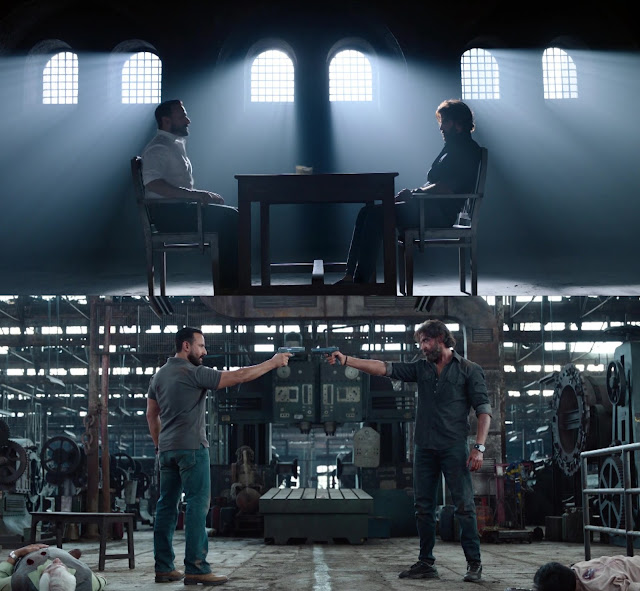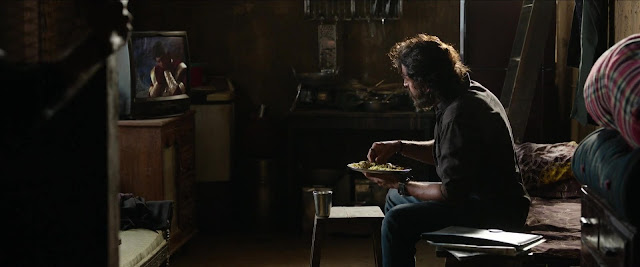By Pankaj Sachdeva
Pushkar and Gayatri’s Vikram Vedha is a film about grey, thematically and cinematically. The grey is present in the characteristics of its protagonists—the good Vikram (Saif Ali Khan) and the evil Vedha (Hrithik Roshan). White is associated with good; black is connected with evil. However, life often combines both, forming grey. There is a little good in evil and a little evil in good. Vikram is a policeman who believes he is fighting crime, but he, too, routinely indulges in encounter killings to dispense justice. Vedha is a local gangster who indulges in political killings but also has inherent goodness. They both are good men; they both are criminals. They both have shades of grey.

Vedha and Vikram are like each other. They both are family men. Vikram is devoted to his wife, Priya (Radhika Apte). Vedha is attached to his younger brother, Shatak (Rohit Saraf). Vikram has encountered people. Vedha has murdered people. So, why is Vikram feted while Vedha is banished? Kala kya safed kya, ki donon mein hai bhed kya, ye khamakha nazar ki bhul hai—Manoj Muntashir’s lyrics in the song Bande explain their similarity. There is not any difference between white and black. It is only a trick played by the vision. The two men also complement each other. Ram ko Ram banaane mein Raavan ka bahut bada haath hota hai. Raavan here has shades of Ram. On Dussehra, Vedha kills the man who branded his brother as a Raavan effigy burns behind him. And Ram here has shades of Raavan. Vikram shoots an innocent Shatak in a fake encounter killing. Characters become a hero or a villain based on a perspective. A villain is a hero in his eyes. Vedha is the Ram of his story. Vedha is the Raavan in Vikram’s story. Vikram is the Ram of his story. Vikram is the Raavan in Vedha’s story.

The aspect of evil and good being similar was also seen in Anurag Kashyap’s Raman Raghav 2.0, which was again a story of a cop Raghav (Vicky Kaushal), and a killer Raman (Nawazuddin Siddiqui). They both were alike. They both were killers. If Raman killed three of his family members, Raghav aborted three children of his own, so what is the difference? Raman uses a car jack to kill his victims; Raghav uses his gun to kill people. They were mirror images of each other. The film’s poster also showed the two men’s half faces merged, highlighting their similarity.

The greyness is also present in Vikram Vedha‘s cinematographic color. Early in the film, Vikram is dressed in a plain white shirt. Gradually, the color of his shirt becomes progressively grey, and by the end, he is wearing a grey shirt. At one early point during the scene, when Vikram is interrogating Vedha in jail, the white light from the window dominates the frame. By the film’s end, the dominant white is replaced with grey. The factory where the film ends has only shades of grey as if reversing the colors of the earlier scene. This grey is in line with the film’s theme.

Vikram Vedha opens with the origin story of King Vikramaditya and the ghost Betaal. These characters are from ‘Betaal Pachisi,‘ which is a collection of stories told to the wise Vikramaditya by the witty Betaal. The stories have philosophical, moral, and ethical conundrums in the context of a life-or-death struggle. As can be guessed, Vikram Vedha is inspired by these folk tales. Here, Vikramaditya is Vikram; Betaal is Vedha. Vedha’s last name is also Betaal. In the film, whenever Vikram and Vedha meet, the latter tells him a philosophical story that also helps unravel the film’s plot. There are three stories here:

1. Chor-Chor: It is easy to choose between right and wrong. But how to select between two wrongs? Which one is worse—the one who committed the crime or the one who gave orders to commit the crime? This forms the dharam sankat of the first story that Vedha narrates to Vikram. The two men use the principle of ek apraadh, ek dand and concur that the one who gave the orders to commit the crime is the more guilty one. This story reminded me of Ravi Udyawar’s Mom which also asked a similar question—”Galat aur bahut galat mein se chunana ho; toh aap kya chunenge?” While telling the story, Vedha uses two water glasses to explain the conundrum, and it is worth mentioning that the glasses are of different sizes—one small and one large—in line with the guilt of his story’s characters.

2. Chor-Chorni: In the first story, Vedha had to choose between two wrongs, but in this one, he has to choose between two rights. The dharam sankat in this story is between maryada ya moh. Principle or attachment. Vedha chooses moh and decides to fight against maryada.

3. Chor-Police: In his third and final story, Vedha reveals the line that separates good and evil—the Lakshman Rekha—is not really a line. It is actually a circle, and all the characters are fighting in that one. The concepts of heaven-hell, truth-lie, and sin-virtue are hogwash. The police is also a chor. One must keep their eyes open and not be blinded by these things. Bhale bure mein fark kya hai, swarg kya hai nark kya hai, ye paap punya sab fijul hai.

Besides Ram and Ravan, Vikram Vedha is teeming with other religious references. There is the mention of Shiv and the snake. There is the mention of Bajrang Bali. There is the mention of King Parashuram. Characters are also named after religious figures. Characters also belong to different religions. In this aspect, it is worth also mentioning the film invokes another fictional superhero Shaktimaan. Shatak believes that Shaktimaan is a hero as he helps the underprivileged. Jo chhote logon ki madad kare. Later, Vedha tries to become Shaktimaan trying to help the poor with his small loans, big smiles program. This again highlights the film’s recurring theme that Vedha is Betaal, but he is also Shaktimaan.

Many mainstream Hindi films focus on daring action sequences. The more the budget, the more daring the action sequences. Vikram Vedha shows that action can be stylized and be made innovative in other ways without involving jumping from skyscrapers and diving from airplanes. The film’s action sequences are so fabulously done by Parvez Shaikh (who also did action for WAR) that they have a certain musicality. Most recently, Anirudh Iyer’s An Action Hero also did something interesting with action, especially the sequences when Maanav (Ayushmann Khurrana) escapes from the police in England. Vikram Vedha has at least four great action sequences.

1. Kisi Ki Muskurahaton Pe Ho Nisar: The said sequence opens with Vedha and several neighborhood guys driving to the fields. A rival gang has kidnapped a young boy. Vedha wants to bring the boy back to protect the turf of his master Parashuram. One of the guys wonders how they will find the boy. “Udaan bharne ke liya na aasmaan dekhna padta hai, zameen nahi. Baaz ki nazar se dekhoge, shikaar shikaari, dono dikhaai denge,” says Vedha. The men then look at the sky and see a bunch of eagles circling, making them infer the kidnappers’ location where the boy has been hidden. One of the kidnappers then picks up a radio and takes a piss. Vedha tries to attack him with a knife but stops as the radio starts playing his favorite song Kisi Ki Muskurahaton Pe Ho Nisar from Anari. The pissing guy sees Vedha and attacks him. Vedha tells him to let the song finish, and they can begin the ‘action.’ However, no one seems to wait, and we see the action where the men attack each other while the song plays. The men fight with sickles. They are thrown into the air. They fall from thatched roofs. They fall in the water. They fall on the rocks. They fall on the tables. They are punched in the face. They splash the sand. They splash the water. They have guns, but it ain’t a gunfight. The dhishoom dhishoom sounds are replaced by the music. All this plays out in slow motion. It is fantastically choreographed like the fight itself is the dance of this song.



2. Walk in the City: Another superbly crafted sequence is the one when Vedha escapes from the policeman when they try to come for him. He calls it a game of ‘aankh-micholi‘—hide and seek. Unlike other films, any other protagonist (or antagonist) would be running and sprinting. Vedha, however, simply walks. He is in no apparent rush. He takes his time. He greets the people he meets on the way. He uses a nunchuk as a pulley on an electricity wire to cross the road. He walks on the terraces coolly while the policemen run around looking for him. In this particular situation, he also behaves like his namesake Betaal, escaping from the police in front of their eyes. The sequence is smooth, just like the Hrithik Roshan dance.

3. Fight in the Market: This particular sequence begins with a traffic jam, and then the action segues into shops of a market. The action occurs in mundane shops, including those selling utensils. In a particularly memorable moment, Vedha drags the face of a goon on the broken glass of a car window. Later, there are more broken glasses and mirrors, and Vedha emerges as the winner.

4. Fight in the Building: Another superbly crafted sequence is depicted when Vedha goes to eliminate Babloo (Sharib Hashmi). The setting is compelling. Babloo’s hideout is an under-construction building. As he goes up the spiral staircase, Vedha kills Babloo’s acolytes with a knife. Rivers of blood flow freely. And Bande plays in the background.

Another notable thing about the film’s action sequences is that they are shot in atypical places. Old monuments, tunnels, factories, tanneries, and havelis. The camera captures the action in compelling frames. While the film is a remake, it also makes sense that it is set in Uttar Pradesh, which of late, has become notorious for its state-sanctioned encounter killings. It was also interesting to see the film showing close-up shots of meat.

Vikram Vedha has fantastic performances by both its leading men. Hrithik Roshan, however, is exceptional. He deserves all the accolades. Vedha’s interaction with his younger brother reminds one of Rohit’s interaction with his younger brother in Kaho Naa Pyaar Hai. The two groups of brothers have a set of hand gestures. Other cast members are not as memorable. The other jarring aspect of the film is the paid product placements. There were just far too many, and they became distracting. These ads feel out of place now, but I realize I am not producing the film. So, whatever works. I wish there were more philosophical elements in the film. But I must say, after a really long time, I have enjoyed watching a Hindi film. Fantastic acting, great action, superb background score, interesting story, beautiful visuals, what is not to like. More of such films, please.

[Read more of the author’s work on his blog here]







